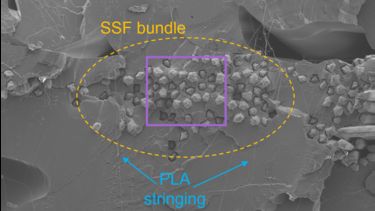Metal 3D printed composite parts are produced containing a polymer matrix and continuous 316L stainless steel fibre bundles (SSF). A 3D printable polymer-SSF filament is first made with a specialised filament maker. The filament is then 3D printed to create a robust composite with the potential to transmit signals as an electrically conductive material.
Continuous stainless steel polymer filaments have been produced using specialised components, by layering 316L SSF with polymers in 3D printed parts to create a robust composite with the potential to transmit signals as an electrically conductive material.
The SSF bundle in this printing study consisted of 90 fibres, each with a 14 Âĩm diameter. The bundle was then coated with polylactic acid (PLA) to produce PLA-SSF continuous filaments with tailored diameters between 0.9 to 0.5 mm. These were then used to print composite parts using the Fused Filament Fabrication (FFF) 3D printing technique.
Inspections of the PLA-SSF composite samples were conducted to evaluate mechanical performance (interlaminar shear strength and tensile property testing), volume fraction and porosity (CT scans and cross-section studies), as well as morphology (microscopy and SEM examination).
The steel fibre volume fraction (VF) in the printed composite structures was controlled in the range of 6 to 12 VF%. The samples exhibited a homogeneous distribution of steel fibres in the PLA matrix. Increasing the volume fraction and lowering the porosity of the PLA-SSF structure, is achieved by alterations to the 3D printing parameters and printer modifications. Parameters include layer height, path width, temperature and cooling.
Based on mechanical testing studies it was demonstrated that SSF reinforcement of the PLA resulted in a significant improvement in mechanical performance, a 5-fold increase in interlaminar shear strength (ILSS). Tensile strength testing revealed that the PLA-SSF composite outperformed other PLA- carbon fibre composites. Furthermore, the PLA-SSF composite is made from polymers that are supplied responsibly, the composite has excellent recycling potential and can contribute to a circular economic material.
There is considerable potential for printed steel composites for individualised conductive composite applications. Compared with previous reports from the literature on 3D printed metal fibre-reinforced polymer composites, the stainless steel composites significantly enhanced mechanical performance. In terms of sustainability, 3D printing has the advantage of minimising material wastage during part fabrication, both the steel and the biopolymer PLA thermoplastic used in the fabrication of the composites are readily recyclable.
It is very exciting that you have been using continuous stainless steel fibres for 3D printing with a continuous path and such a high volume fraction with low porosity.
Mazher Iqbal Mohammed
Leader of Product Design Engineering at Loughborough University
EQUIPMENT
- 3devo filament maker (modified)
- Anycubic 3D printer (modified)
- GE Nanotom X-ray micro-computed tomography (ÂĩCT) scanner
- Olympus DSX1000 microscope
- Hitachi tm1000 scanning electron microscope
- Zwick Roell Z005 and Lloyd 6000S mechanical testers, with 10kN and 30kN load cells, respectively.
IMPACT
PLA-SSF continuous filaments can be fabricated on a normal polymer printer with minimum modifications, which opens up the potential for a broad range of users to utilise this technology. It provides an alternative to other reinforcing fibres currently used in aerospace, biomedical, marine and energy sectors. Potentially for high-pressure containers, faraday cages, signal or information transmission vessels with competitive strength values compared to continuous carbon fibre structures.
BIO
Alison Clarke holds an MA in Engineering with Management, Mechanical and Manufacturing, from Trinity College Dublin, and is currently completing her PhD in Additive manufacturing of continuous fibre-reinforced polymers at University College Dublin with the AMSCDT.
Alison is an enthusiastic, creative design expert, with a background in mechanical and manufacturing engineering, alongside the marine industry.




